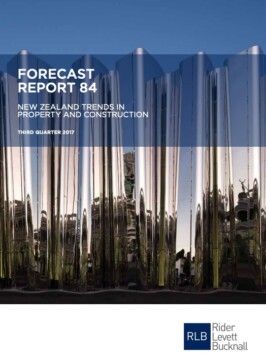The Rider Levett Bucknall (RLB) Forecast 84 report – New Zealand Trends in Property and Construction – released today confirms that beyond 2017, the construction outlook remains strong, supported by the continued surge in net migration.
Prepared by the New Zealand Institute of Economic Research (Inc.) (NZIER) exclusively for RLB, Forecast 84 highlights the demand for new accommodation buildings continues to rise, reflecting the surge in tourists.
Highest migration in over 20 years
Geoff Speck, Director of RLB in Auckland said, ‘Net migration into Auckland of around 35,000 over the past year was the highest in over 20 years. This is the biggest driver of building activity in the region.’
He added, ‘Although Auckland Council is issuing more dwelling consents than in previous years, the housing stock is not growing in line with the population. The increase in the number of permanent migrants has boosted demand in the New Zealand economy, particularly construction activity and retail spending.’
Jobs in trades lead increase in work visas
According to Forecast 84, it has also expanded the labour supply. The increase in work visas issued over the past year have been led by jobs in trades, and this has helped to mitigate labour shortages in the construction sector.
Construction demand in the ‘halo’ regions of Waikato and Bay of Plenty increased particularly strongly. This strong growth reflects the spill-over effects of strong population growth from Auckland
Vacancy rates for prime office space at historic lows
Demand for new accommodation buildings remains very strong, while demand for new office buildings recovered. With vacancy rates for prime Auckland office space at historic lows, with the demand for new office buildings expected to continue to grow.
The average value per square metre has continued to lift sharply, in line with strong growth in other construction cost measures.
Tourism and population growth drives non-residential construction demand
Hotels, healthcare facilities and office space were the top three drivers of non-residential
construction demand over the past year. This reflects the effects of strong tourism activity and population growth.
According to Forecast 84, economic growth is expected to pick up over the coming year, underpinned by solid household spending, business investment and a recovery in exports. The recovery in global dairy prices will also support the solid New Zealand economic growth outlook.
Solid construction growth outlook and a lower inflation environment
Geoff continued, ‘We forecast construction cost inflation to moderate to below 5 percent by the second half of this year. Beyond 2017, annual construction cost inflation should average around 3.5 percent.’
‘Despite the solid construction growth outlook for the next three years, we do not expect inflation to be as sharp as the mid-2000s, given that the lower inflation environment limits the extent to which rising costs can be passed on quickly, and strong net migration is helping to mitigate skills shortages in the building sector,’ he concluded.
FURTHER INFORMATION:



